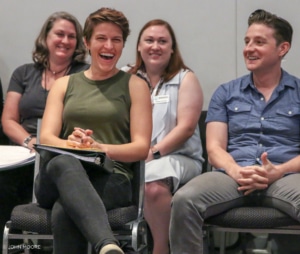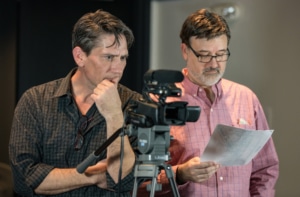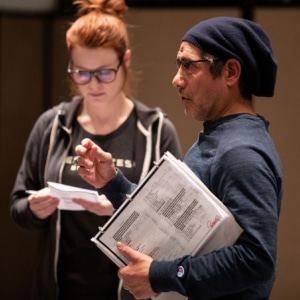DCPA NEWS CENTER
Enjoy the best stories and perspectives from the theatre world today.
Enjoy the best stories and perspectives from the theatre world today.
This article was originally published on November 17, 2022
All the books, lessons and performances in the world won’t guarantee an actor a leading role, but mastering the art of the audition just might. That’s why for the past five years Grady Soapes, the DCPA Theatre Company’s Director of Casting, has long taught classes on how to perfect the art of the audition. And, now, he shares some of the advice he gives his students.

Executive Director of Education, Allison Watrous, works with the cast of They Stole the Moon by Ricardo D’Urso
“What I want all actors to leave with is that we are on their side. It’s their audition and their moment to make an impact and get cast in these roles,” said Soapes. “We don’t want people to fail. It’s not as cutthroat as you see on film or TV. If you have been asked to come in the room, it’s because we as a creative and casting team are rooting for you and we want you to get this job.”
Of course there are some steps an actor can take to help secure this role.
OWN THE ROOM
Often, noted Soapes, there’s trepidation when an actor walks in the audition room. They want to know what to do, but for Soapes, he would rather the person come into an audition and take charge of the space. After all, he added, it’s all yours for the next five to ten minutes.

Photo by John Moore
“Embodying that space in whatever way that means for you, is exciting for us as casting directors. It means you’re taking the audition seriously,” he said. “It’s great to see someone walk in with a purpose. They don’t ask for permission, they just let us know what they’re doing.”
He also suggests not apologizing if a line is missed. If you want to run it again, simply say you messed up and want to start from the beginning.
“A casting director sees people time after time, and if we have to continuously explain the process and listen to apologies and answer questions, it just gets tiring,” he added.
BE RECOGNIZABLE
It might sound obvious, but it’s important that your head shot looks like you. Or at least, said Soapes, that you add a snapshot with the headshot if you have drastically changed something that will make it hard for them to recognize you. Also note why the snapshot differs from the headshot you turned in, for example, because it’s two years old and now you have a beard.
 “Sometimes, if you audition on day four of a five-day run, it’s good to have a current reminder of who you are,” suggested Soapes, who understands how expensive a head shot can be and doesn’t want people rushing out to replace them all the time. “The casting director might turn that headshot over and not remember that person walking into the room, because, oh, they have pink hair now.”
“Sometimes, if you audition on day four of a five-day run, it’s good to have a current reminder of who you are,” suggested Soapes, who understands how expensive a head shot can be and doesn’t want people rushing out to replace them all the time. “The casting director might turn that headshot over and not remember that person walking into the room, because, oh, they have pink hair now.”
Resumes too should be recognizable on the employment side. Soapes wants to see your theater work up front to see how your work applies to what you’re auditioning for.
Then, make sure the credit includes the play, the role, the theater and the director.
“Your resume is also a referral. If I see you worked many times with a director I know and adore, that in and of itself is a referral,” said Soapes.
THE SIX S’S
One key method Soapes teaches is the Six S’s, a methodology for walking into the room and winning that audition, all based on six key components.
 1. Slate
1. Slate
The first part is slate, or your introduction to the casting team. That’s where you tell them who you are, what monologue you will be doing and perhaps what song.
“This is letting us know who you are and what you’re doing in the audition process,” said Soapes, who suggests you make the slate as personal as possible. “In a lot of instances it’s the slate where we get to know you the most, as it’s the time when you’re not acting.”
2. Set Scene
Next comes set scene, where you visualize for yourself where the action will take place and set it up for the casting team to follow. If you’re a writer at a desk about to work on an article, well, make sure the people watching gather that before you say a word.
3. Story
The third S is story, a tricky part considering auditions consist of just a snippet of the larger picture.

Photo by Brian Landis Folkins
“You really have to concentrate on what the story you are telling is and do it in three minutes,” said Soapes. “It requires research on what happened, and what is going to happen.”
For example, is your character stressed because they found out something important that’s causing conflict? If so, make sure that’s apparent from the moment you start the dialogue. Then, give the casting team the sense that the conflict will be eased, even if you don’t actually get there during the speech. This, added Soapes, is the real job of the actor.
4. Simplicity
Simplicity comes next, and Soapes recommends you leave something to build on rather than throwing everything into the character.
 “As a casting director, if I love what you’re doing, we can layer in emotion,” he said. “But if someone throws everything in, then we have to peel away layers, and that’s hard.”
“As a casting director, if I love what you’re doing, we can layer in emotion,” he said. “But if someone throws everything in, then we have to peel away layers, and that’s hard.”
He added if the actor starts simple and the team can build on it, it shows that they can be directed, flesh out a character and adjust when needed. Those qualities, he said, are what will get someone a call back.
5. Stillness
The fifth S goes hand-in-hand with simplicity, stillness, meaning one should ground themselves to an area rather than try and take over the whole room. This aspect, said Soapes, is important. Because, if the actor can come in and capture the teams’ attention without running around, it shows real skill and promise.
6. Sayonara
The last aspect is sayonara, which means “goodbye” in Japanese. In essence, said Soapes, this final S means, “be bright, be brief, be gone.” Don’t linger and make small talk, leave with the same grace and command over the space that you came in with.
Learn more about the art of audition in one of Soapes’ advanced acting classes at the Denver Center for the Performing Arts. Taught multiple times a year, these include Theatre Audition Intensive, Advanced Auditioning Sampler (Soapes teaches one of the three sessions), and Advanced Auditioning: Tools for the Callback.
